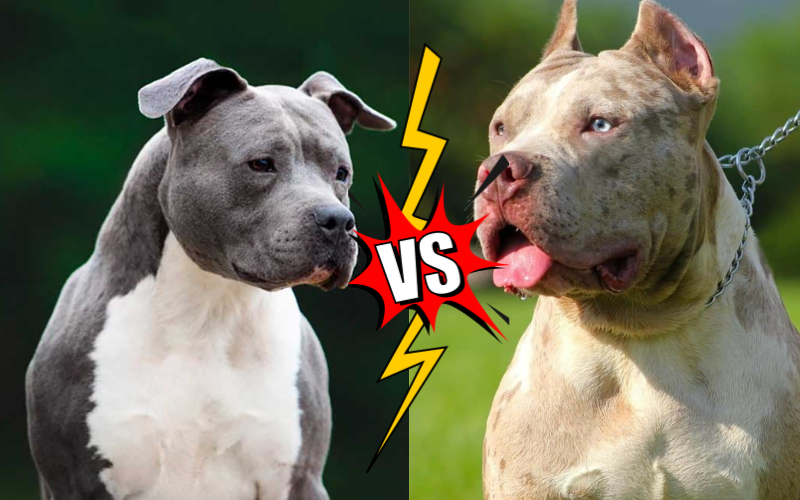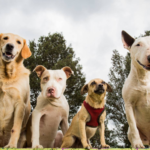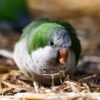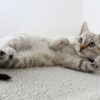- How Long Does A Quaker Parrot Live? - 17 May 2024
- 4 Hacks on Keeping Your Home Clean With Pets - 28 March 2024
- 5 Things to Know Before Bringing Home a New Kitten - 26 March 2024
Despite the stigmas they sometimes face both Staffordshire Terrier vs Pitbulls can be loving and affectionate dogs. They require responsible ownership and early socialization to prevent their natural aggression from affecting other animals or humans. Those who are new to dog ownership may find it difficult to distinguish between these two breeds, which share similar characteristics and histories.
Overview of Staffordshire Terrier vs Pitbull
Regardless of their differences both the Staffordshire Terrier and Pitbull breeds can make excellent companion dogs when they are raised in a loving environment with responsible owners. They are affectionate loyal and energetic. They should also be socialized early so they can become confident around new people places and situations. Both breeds can become aggressive, but this depends on the dog’s upbringing and how they are treated. They are often misunderstood by the public. Which has led to breed specific legislation in some areas.
However responsible ownership education and advocacy can help change the public perception of these magnificent dogs. Both the Staffordshire Terrier and Pitbull breeds have a strong muscular build. While they are similar in appearance the Staffies have a stockier wider head and are larger overall. Pitbulls are leaner and more streamlined in shape.
Staffordshire Physical Characteristics

| Characteristic | Description |
| Size | Medium to large |
| Weight | 55-70 pounds |
| Height | 17-19 inches at the shoulder |
| Coat | Short and smooth |
| Head | Broad and muscular |
| Ears | Small, rose-shaped |
| Eyes | Dark and round |
| Legs | Straight and well boned |
The Staffordshire terrier is medium sized with a compact yet muscular build and a short coat of various colors. It has a broad head with defined occipital muscles well placed shoulders and a short foreface. Its jaw is wide with a scissor like bite and its ears are small. This dog has a strong athletic ability and is distinguished by its innate loyalty to family members. It is also a highly intelligent and fearless animal.
Pitbull Origin Physical Characteristics

| Characteristic | Description |
| Size | Medium to large |
| Weight | 30-85 pounds |
| Height | 17-21 inches shoulder |
| Coat | Short and smooth |
| Head | Medium-sized, broad |
| Ears | Can be cropped or left natural |
| Eyes | Round to almond-shaped dark |
| Legs | Strong and well-muscled |
In 19th century Britain immigrant workers started breeding Old English bulldogs with terriers to create dogs that would have the power and agility of bulldogs and the gameness of terriers. These dogs eventually became the ancestors of Pitbull and Staffordshire Terriers. They were bred for their ability to fight other animals and humans in dogfighting rings. These ghastly “blood sports” were banned in 1935 but not before pit bulls developed a bad reputation that persists to this day.
Training Techniques for Staffordshire Terriers
please, making them a joy to work with. They respond well to positive reinforcement and training should start early so that they can be socialized and exposed to different situations. This will help them to learn that humans are not threats and will make them more accepting of strangers and other animals. These dogs are active and will need plenty of exercise. Especially in a large backyard or play area. They may also need to be crated when left home alone to prevent destructive behavior such as digging and chewing.
Regular mental stimulation will also help to channel their energy and keep them from becoming bored and destructive. Due to their history of being used in dog fighting. These breeds have a tendency to be aggressive towards other dogs. To avoid this they should be trained in obedience commands as puppies and should be exposed to other dogs frequently to ensure that they do not feel threatened by other animals.
Health Considerations
Staffordshire Bull Terriers require regular exercise to maintain their physical and mental health. They need long walks and the opportunity to participate in organized canine sports. This breed is sensitive to temperature extremes and should not be overworked in hot weather. This breed has an unwarranted reputation for aggressiveness but it is not a naturally dangerous dog. If properly socialized during early puppyhood.
They are loving and affectionate companions that can also be playful with children. This breed is genetically predisposed to a variety of eye conditions. Such as nuclear sclerosis and juvenile cataracts. They are also susceptible to patellar luxation. Which occurs when the kneecap dislocates from its proper position. In addition. They can suffer from allergies and skin issues. When selecting a Staffordshire Bull Terrier.
Influences on Breed Popularity
Both the Staffordshire Terrier and the Pitbull are loyal dogs with a muscular build. They make great companions for families and are known for their friendly nature. However they should not be taken lightly. They require a lot of exercise and attention and they need to be properly trained. The decision to choose a breed should be based on lifestyle preferences and ability to meet the needs of the dog. It is also important to research consult with professionals and consider adoption from reputable shelters and breed specific rescues.
According to studies movies featuring a particular breed can influence breed preference for up to 10 years after release. While this may seem like a powerful marketing tool. It is not without some negative consequences. Both the Staffordshire Terrier and the Pitbull have a history of dogfighting and they can develop aggression if they are not raised in an environment that supports responsible breeding. Additionally they are prone to elbow and hip dysplasia. Which can lead to pain or lameness. They are spirited and robust breeds that need hour-long exercise daily to burn their energy.
ideal Living Arrangements
Though American Staffordshire Terriers and Pitbulls have a bad reputation for being aggressive. They make loving family pets with proper training and socialization. They enjoy being part of the family and love having a job to do excelling in dog sports and other activities such as training. They’re courageous and confident traits that made them effective working dogs in the past. Their sociability with people also extends to children. Who they adore and are affectionate toward. However their protective instincts may make them hesitant to approach strangers or other animals.
AmStaffs are relatively healthy dogs and live long lives. However like any breed they prone to certain conditions. They can develop skin allergies that manifest as rashes and itching or urinary tract infections (UTIs). Which can lead to pain and discomfort. They’re also prone to osteoarthritis. Luckily these issues are preventable with regular exercise and attention to their diet. In this world both find or want to make pet kingdom in our sweet homes.
Performance in Competitions
The Staffordshire bull terrier has the heart and strength to succeed in many dog sports from agility to obedience. These dogs love to be part of the action and don’t have an “off” switch. However, their history of violence has a tendency to resurface and trigger suppressed genetic tendencies towards belligerent behavior in certain situations. Though docile in general even the most well-trained AmStaff may bite if they feel their family or property is under attack feel threatened by another animal or human or are upset about a perceived unfair treatment of themselves.

This behavior is not their fault and can be mitigated with proper training. Although AmStaffs are often referred to as pitbulls. They are not considered pitbulls by the United Kennel Club. Despite their physical similarities. A true pitbull is a separate breed from the Amstaff and has a distinguished red nose. You should never own two Staffordshire bull terriers at the same time. As they may bond with each other and ignore you. This can cause unsolvable disciplinary issues down the road.
Staffordshire or Pitbull Performance in Shows
While both breeds can be aggressive towards other animals and humans they don’t know, this formerly bred-in aggression can be overcome with proper training. Well-socialized Staffies and APBTs are loving dogs and companions that make great family pets. They are also good-natured and energetic athletes that can be trained in dog sports like agility or weight pulling. The main difference between a Staffordshire Terrier or pitbull yorkie mix and an APBT is that Staffies are larger than APBTs with a stockier build and broader head.
The APBT breed standard stresses proportions that avoid rangy or leggy dogs and squat or broad ones. They are also more likely to have a naturally uncropped tail than Staffies.As well as heart issues in later life but responsible ownership and education can help to mitigate these problems. They can also be subject to breed-specific legislation due to their history of use in dog fighting and bull baiting. Which can lead to restrictions on ownership and training. Responsible owners can advocate for their breed. Helping to change public perception over time.
Rescue Stories and Successes
Pit bull-type dogs like American Staffordshire Terriers and pitbulls are often mischaracterized as dangerous. This is largely due to their history of use in dog fighting. Which has damaged their reputation. However responsible ownership and education can change public perception over time. One example of a successful hero pit bull is a dog named Angel who saved the life of a woman and her child. He spotted them being attacked by a Puma and rushed to their aide. He was able to fend off the animal and eventually kill it.
This hero was subsequently adopted by the woman and her son and now lives happily with them in Florida. Despite their impressive strength and stamina. Pitbulls are generally easy to train and thrive in a loving family environment. They do however require a lot of exercise and mental stimulation. Some regions may also have breed specific laws that restrict ownership or impose additional requirements for these dogs. So be sure to check out any local restrictions before considering this breed.
Changing Perceptions in Communities
The perception of these dogs as inherently aggressive can be changed with responsible ownership and education. It is also important to understand that their temperament can vary by individual and that early socialization is key to developing a well-rounded dog. Both Staffordshire Terriers and pitbulls are affectionate, loyal and good-natured toward their owners. They do best in homes that have adequate space for them to spend time both indoors and outside. They require regular exercise and mental stimulation.
While both the American Staffordshire Terrier and the Pitbull are often unfairly associated with dog fighting. They have since been bred for many other uses including as family pets. Some areas have breed-specific laws that restrict or impose additional requirements for ownership. According to a study by the Animal Rescue Foundation participants who worked in shelters affected by BSL were more likely than those in non-BSL communities to use physical features to determine a dog’s breed and that they would euthanize dogs they thought to be Pomeranian pitbull mixed.
Staffordshire Terrier or Pitbull in Media
Staffordshire Terriers and pit bulls have an unfair reputation as dangerous. Aggressive dogs that are capable of harming people. Despite this they are actually smart loving family pets that require early training and socialization to thrive. They have a robust build and are great for active families with older children. They also excel at dog sports like dock diving, weight pull competitions and scent work. They are incredibly loyal and affectionate to their owners and love to curl up with them under the covers on cold nights.
While it is common for people to use the names merle pitbull and staffy interchangeably. According to Pit Bull Rescue Central the American Kennel Club recognizes the Staffies as a distinct breed with its own standards and criteria. The AKC defines the term pit bull to refer to several different breeds including the American Staffordshire Terrier. Both Staffordshire terriers and pitbulls are prone to certain health conditions, including hip dysplasia and allergies. However with proper nutrition, exercise and routine veterinary checkups they can have long healthy lives.
Family Compatibility
The American Staffordshire Terrier and pitbull are people oriented dogs with affectionate natures that make them loyal companions. They are also athletic and energetic and require regular exercise and mental stimulation. However they do not thrive in isolation and may develop anxiety or aggression as a result. Responsible ownership training and early socialization are vital to ensuring these dogs have a healthy and fulfilling life as part of a family. It is important to remember that the perception of these breeds as inherently aggressive is a stereotype and they can be inherently friendly and non aggressive when raised in a nurturing environment with responsible owners. Both breeds have a tendency to overheat.
So it’s important to keep them well hydrated and cool. Routine ear cleaning dental care and regular visits to the veterinarian are all essential for the maintenance of their health. These breeds can suffer from a variety of health issues including heart problems Cerebellar Abiotrophy and joint conditions. These diseases can be prevented with the proper vaccination and nutrition and by ensuring these dogs are well socialized and trained.
Final Thoughts
Both the Staffordshire Terrier and Pitbull have a fierce reputation, but this is mostly undeserved. Both breeds are loving, incredibly devoted dogs that make excellent companions for families, children and other pets. As a result of their history with blood sports, they have a strong urge to defend their owners and loved ones. However, this doesn’t mean that they aggressive by nature. They will only attack if they perceive a threat to their family. Both breeds have many similarities including their physical traits temperament and training needs.
















